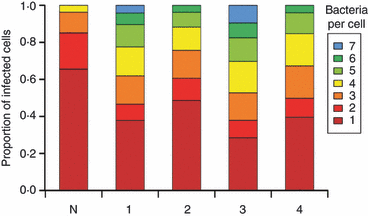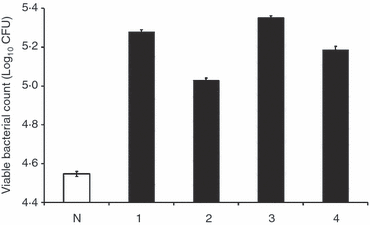Human IgG isotypes and activating Fcγ receptors in the interaction of Salmonella enterica serovar Typhimurium with phagocytic cells
- PMID: 21323662
- PMCID: PMC3088969
- DOI: 10.1111/j.1365-2567.2011.03411.x
Human IgG isotypes and activating Fcγ receptors in the interaction of Salmonella enterica serovar Typhimurium with phagocytic cells
Abstract
Several classes and multiple subclasses of immunoglobulins are produced towards protein and polysaccharide antigens in response to Salmonella infection and play a key role in protection against systemic disease. The targeting of Salmonella to Fc receptors (FcR) on phagocytes is a key step in the antibody-mediated antibacterial functions of host cells. We wished to compare the relative efficiency of different human IgG subclasses, which targeted the Salmonella enterica OmpA surface protein in modulating the interaction of bacteria with human phagocytes. To this end, we developed a novel system by tagging OmpA with a foreign CD52 mimotope (TSSPSAD) and opsonizing the bacteria with a panel of humanized CD52 antibodies that share the same antigen-binding V-region, but have constant regions of different subclasses. Our data revealed that opsonization with all the IgG subclasses increases Salmonella uptake by human phagocytes. IgG3 resulted in the highest level of bacterial uptake and the highest average bacterial load per infected cell, which was closely followed by IgG1, then IgG4 and lastly IgG2. Phagocytosis mediated by IgG1, IgG3 and IgG4 had a higher dependency on FcγRI than FcγRIIA, whereas IgG2-mediated phagocytosis required FcγRIIA more than FcγRI. The results show that IgG binding to OmpA increases the uptake of Salmonella by human phagocytic cells and that the efficiency of this process depends both on the subclass of the IgG and the type of FcR that is available for antibody binding.
© 2011 The Authors. Immunology © 2011 Blackwell Publishing Ltd.
Figures






References
-
- Bhutta ZA, Threlfall J. Addressing the global disease burden of typhoid fever. JAMA. 2009;302:898–9. - PubMed
-
- Gilks CF, Brindle RJ, Otieno LS, et al. Life-threatening bacteraemia in HIV-1 seropositive adults admitted to hospital in Nairobi, Kenya. Lancet. 1990;336:545–9. - PubMed
-
- Graham SM, Molyneux EM, Walsh AL, Cheesbrough JS, Molyneux ME, Hart CA. Nontyphoidal Salmonella infections of children in tropical Africa. Pediatr Infect Dis J. 2000;19:1189–96. - PubMed
-
- Graham SM, Hart CA, Molyneux EM, Walsh AL, Molyneux ME. Malaria and Salmonella infections: cause or coincidence? Trans R Soc Trop Med Hyg. 2000;94:227. - PubMed
-
- Bronzan RN, Taylor TE, Mwenechanya J, et al. Bacteremia in Malawian children with severe malaria: prevalence, etiology, HIV coinfection, and outcome. J Infect Dis. 2007;195:895–904. - PubMed
Publication types
MeSH terms
Substances
Grants and funding
LinkOut - more resources
Full Text Sources
Other Literature Sources
Medical

